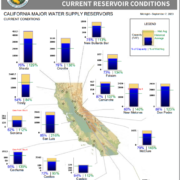Most of us operate on the calendar year — the 12 months that begin on January 1 and end on December 31. Many governments and major corporations use the fiscal year — typically beginning on July 1 and running until June 30 of the following year. However the federal government’s fiscal year, which began on July 1 for 132 years, was shifted in 1974 to an October 1 start to accommodate federal officials’ insistence on a month-long escape from Washington’s steamy summer weather.
In California, the most important calendar may be the “water year,” which also begins on October 1, because how much the state’s reservoirs have in storage and how much nature provides in the form of rain and snow are existential factors in the lives of nearly 40 million people.



